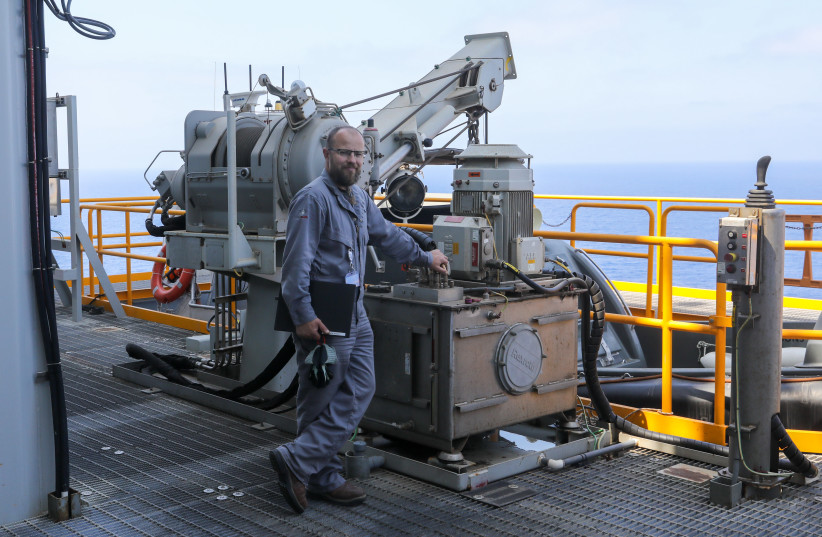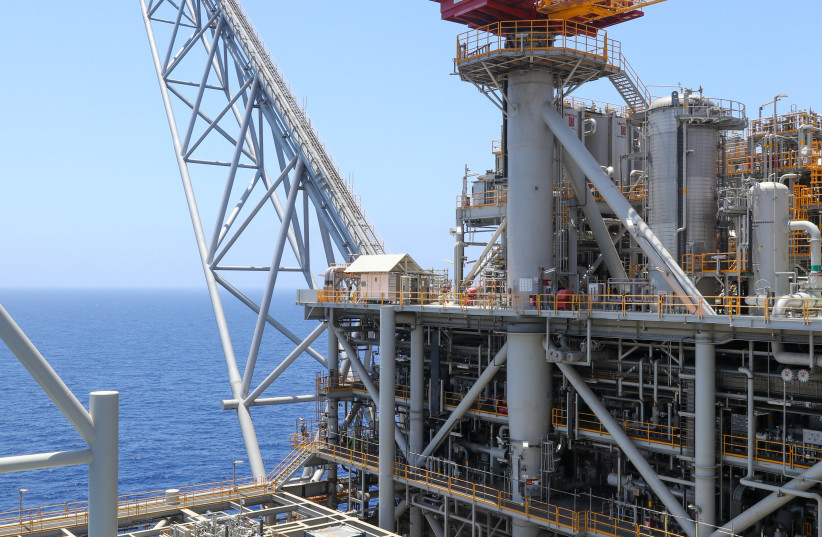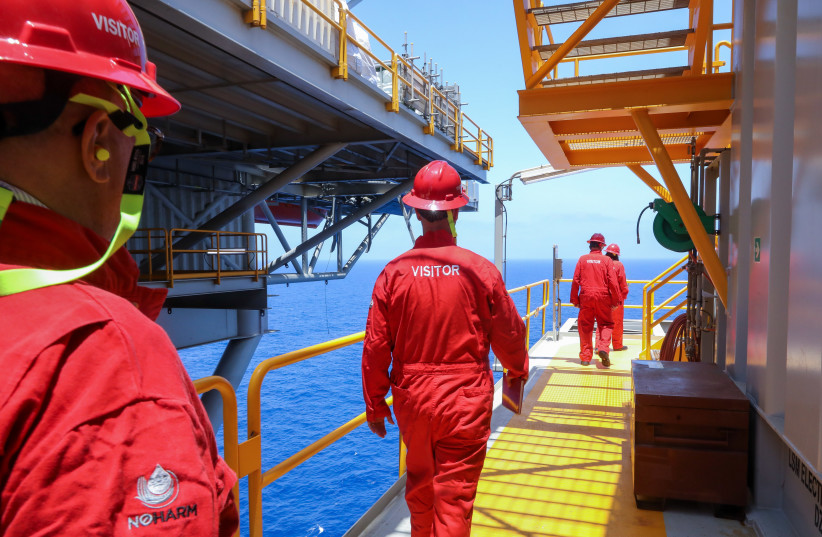A visit to the Leviathan gas rig off the coast of Haifa illustrates the country’s opportunity to up its gas game and wield its diplomatic power across the globe.

The first thing you notice when you land on a gas rig is how something that looks so small on the horizon is actually quite big, and Leviathan – the mammoth gas platform stationed off the coast of Haifa – does not disappoint.
With three main levels and pipes that seem to go on forever – leaving you to wonder how someone figured out how to connect them all – Leviathan is the largest gas rig in Israeli waters that receives gas from the country’s largest gas reservoir located well over 100 km away. The gas flows through the rig where it is cleaned and then propelled directly to Israel where it immediately powers our country.
Together with a few other Jerusalem Post writers, we visited Leviathan a few weeks ago to learn more about Israel’s gas industry and the opportunities that might exist for Israel to leverage its geopolitical standing. The reason is simple – the Russian invasion of Ukraine has opened what some in the industry call “historic opportunities” for the Jewish state to up its energy game and, in return, increase its diplomatic value and standing in the Middle East and beyond.
The illustrations of this are bountiful, but here are just two: In March, President Isaac Herzog flew to Turkey and met with President Recep Tayyip Erdogan. Last month, Turkish Foreign Minister Mevlut Cavusoglu visited Jerusalem for talks with Foreign Minister Yair Lapid.
Ankara is heavily reliant on Russia for energy – including 45% of its natural gas and 17% of its oil. Reconciliation with Israel and improving relations is key for Turkey to be able to potentially diversify its suppliers and cut back its dependence on Russia, no longer a reliable energy source.

The second example was the flip-flop that Israeli Energy Minister Karin Elharrar did on May 30 when she announced that her ministry would be issuing licenses for new exploration of natural gas in Israeli waters. It was a sharp turn from what the Yesh Atid minister had announced just six months earlier in December 2021.
Then, Elharrar said that “in the coming year we will focus on the future, on green energy, on energy optimization and on renewable energy, and while we do so we will put aside the development of natural gas, which, as is known, is [a] short-term solution.”
By May 30, Elharrar was singing a different tune: “The global energy crisis provides an opportunity for the State of Israel to export natural gas, along with the honest and real concern for what is going on in Europe.”
“The global energy crisis provides an opportunity for the State of Israel to export natural gas, along with the honest and real concern for what is going on in Europe.”
Energy Minister Karin Elharrar
What changed in six months? A global energy crisis and recognition that Israel has a role that it can play to help alleviate it and at the same time improve its international standing.
“The world changed and we cannot ignore it,” said Energy Ministry Dir.-Gen. Lior Schillat. “There is a rise in the demand for gas especially in Europe since the Russia situation and they need a steady supply and the minister did a reassessment in the middle of the year instead of at the end of the year since we think it is possible to increase the supply.”
Oded Eran, Israel’s former ambassador to the European Union, said that the developments in Europe are a historic opportunity for Israel and the energy minister’s policy reversal needs to be looked at through that prism. On the one hand, Eran explained, was the populist-driven decision last December to stop exploration which had wanted to put Israel on track with the climate change camp while ignoring the economic and diplomatic opportunities that gas provides the country.
Until now, Eran added, Israel was not viewed as an international energy player but just as a regional one. “But now with the war in Ukraine, you can see that Israel is not unimportant,” he said.
As an example, Eran referred to US President Joe Biden’s promise in March to transfer 15 billion cubic meters (BCM) of liquefied natural gas to Europe by the end of 2022 to help with the shortfall caused by the war in Ukraine. Israel, he said, already exports about 10 BCM of natural gas to Jordan and Egypt.
“This is not far from the amount that Biden promised Europe,” he said.
The Rig
Leviathan is like an all-inclusive office/hotel. Deceptively, it houses well over 100 workers who work, sleep, eat, exercise and rest on the premises for 28 consecutive days.
Many staffers are Americans who fly back home for a month before returning for another month’s duty. In the staff roster during our visit, there was one female engineer present.
In the control room that reminds men of a certain age of the deck of the Starship Enterprise, personnel monitor hordes of screens, control panels, knobs and doohickeys 24/7 that control the natural gas that flows to Chevron’s clients in Israel, Egypt and Jordan.
The screens show everything – from the pressure in the pipeline that connects the rig with the well 100 km. away as well as the filtration of the gas as it goes through the endless pipes and tubes on Leviathan. The controllers receive orders from Israel Electric Corporation the night before based on the weather and assessments of how hot it will be and how many people will be using air conditioning or heat.
Once the gas flows it cannot immediately be stopped and it needs to go somewhere since the rig doesn’t store gas – it pulls from the well, filters it and sends it to the coast. This is why if a customer wants to make changes to an order, it needs to give at least half-an-hour notice ahead of time.
Sitting in comfortable swivel chairs, with a wealth of American and Israeli snack food perched on nearby shelves, the controllers articulately explain to visitors what they do; all are men with twinges of Southern accents.
Where are you from, they’re asked. “Louisiana.”
“I’m from Louisiana too.”
“Louisiana, here,” chimed in a third, noting that most of them had grown up in the oil industry with their fathers working on rigs themselves. They explained that it was worth their while to fly every month to the other side of the world and spend a month on this contraption in the middle of the ocean.
Most of the crew we spoke to had been working that month-on/month-off cycle for close to two years. And aside from the drive from Ben-Gurion Airport to Haifa to catch the helicopter to the rig, none of them had spent any time in Israel.
“Hopefully, now with corona [COVID-19] on the wane, we’ll be able to visit some places like Jerusalem,” said one engineer on the deck.

The southern orientation of some of the crew might explain the cuisine in the spacious, modern dining room. Amid the plentiful trays of rice, fresh vegetables and chicken legs was another entrée of Cajun jumbo shrimp. The food is brought in twice a week via ship from Ashdod.
When the crew feels like working off the ample food supply, which includes a fully stocked ice cream freezer and soft drink fridge, they go to an extensive gym boasting state-of-the-art equipment.
And when it’s time to just veg out, there’s the movie room, which on visitors’ day was showing the classic Mel Brooks comedy Blazing Saddles.
It’s probably a good thing that the crew gets their guffaws out of the way here because when they’re on the job, there’s no time for levity. A gas rig is a potentially dangerous place. After all, it’s flowing with highly flammable gas. Jim, the manager of the rig when we were there, wore a device on his belt that measured gas fumes in the air. This was in case there would be a leak. In addition, all visitors need to put on metal-tipped boots – in case something heavy falls on you – as well as fire-resistant overalls which of course came in one color – bright red.
Chevron took over Leviathan in October 2020 when it completed the acquisition of Noble Energy, the original company that had explored the gas field and then built the rig that now extracts its gas. The companies are almost incomparable. Chevron is huge compared to Noble and is involved in all aspects of oil and natural gas: exploration, production, refining, transport, chemicals and more.
And like anything that has to do with energy, the gas industry does not lack its critics. Environmentalists and climate change activists have repeatedly slammed Israeli gas policy over the years, claiming that the rigs are dangerous to the environment, harm the air and more.
This article is not about climate but here are two data points that are important to keep in mind. Until seven years ago, coal was the fuel for almost 50% of Israeli energy production. Today it is already less than 20% – 70% is gas and about 10% is from renewables (solar and wind) – and it will be completely stopped by 2025, in just three years.
Now think about this – the dramatic reduction in coal use has led to a 50% decrease in pollution of NOx (nitrogen oxides) as well as SO2 (sulfur dioxide), which together causes a wide range of respiratory diseases. The decrease in coal has also allowed Israel to keep its commitment to the 2016 Paris Agreement, which required signatories to reduce CO2 emissions.
Would the world be a better place if we could supply all our energy needs from the sun and wind? Of course it would. And could Israel possibly do more to invest in renewables? For sure. But when considering reality, Israel is in a pretty good place.
The map
Israel currently operates three major gas fields. Tamar was the first that was found in 2009, around 90 km. west of Haifa in the northern part of Israel’s economic waters. At the time of discovery, Tamar was estimated to contain some 240 BCM of gas reserves, an amount that can alone provide for Israel’s domestic gas consumption for several decades.
A year later, Israel made its greatest discovery when the Leviathan field was found in deep water, 30 km. west of Tamar. Initial analysis indicated it held 450 BCM but that number later went up to 500. It was at the time the largest gas discovery in the world. With success, more exploration was done and the Karish and Tanin fields were found, amounting to about 100 BCM.
A few weeks ago, Energean – a British-based company that will develop the fields – marked a major milestone with the arrival of its floating gas rig – called an FSPO – at Karish. Gas flow is expected to begin toward the end of the year.
Currently, Israel exports its gas to two countries: Jordan and Egypt, which recently increased the amount of gas it receives from Israel to meet domestic needs. Export licenses are approved by the government in coordination with commercial companies like Chevron. On the one hand, Israel has to want to sell to a specific country; on the other hand, Chevron has to see whether it can practically meet the demand.
The amounts are there. According to the Energy Ministry, Israel currently has close to 1,000 BCMs of gas reserves while the country’s own domestic needs are unlikely to exceed 500 BCM for decades to come. Assuming there is still another 500 BCM that has yet to be found – companies are already vying for exploration licenses now that Elharrar has changed her mind – and that would mean that Israel could have up to 1,000 BCM available to export to the world.
The opportunity
And this is exactly the opportunity that Israel finds itself facing – what to do with all this gas.
The primary challenge is how to get the gas from the Mediterranean to Europe. Up until a few years ago, Israel seemed to have a clear plan called the Eastern Mediterranean Pipeline (EastMed) pipeline, an ambitious and costly project that would connect the gas fields to mainland Europe in partnership with Cyprus and Greece. But then in January, the Biden administration walked away from the plan, citing economic and environmental obstacles.
This is where Turkey has stepped into the picture. After the announcement that Washington no longer supported the EastMed, Erdogan claimed that the only viable route to Europe is through Turkey.
“[If Israeli gas] would be brought to Europe, it could only be done through Turkey,” the Turkish president said at the time. “Is there any hope for now? We can sit and talk about the conditions.”
Another option would be to export to Europe via two existing liquefaction plants in Egypt and then ship it to Europe where it will be converted back into gas.

A floating liquefied natural gas (FLNG) facility is also being discussed which would allow shipments to Europe directly from Israel.
In a report presented to both Israel’s Foreign Ministry and the European Parliament, gas consultant Gina Cohen concluded that Egypt would be the quickest route to Europe while a FLNG would offer independence from any transit country. A direct pipeline would provide the cheapest end-consumer price, she said, but it take years to build.
“Israel must act as quickly as possible as the window to sign contracts and become a significant gas supplier to Europe will only be opened for a limited time,” Cohen said.
Jeff Ewing, managing director of Chevron’s Eastern Mediterranean Business Unit, said that Leviathan is capable of upping its production with new wells, added facilities on the rig and additional subsea infrastructure. Project teams, he said, are already at work drawing up options for the company to present to the State of Israel.
“We want to utilize the facility to the fullest extent,” Ewing said. “We need to supply the domestic market and then we want to use what is left for exports.”
The talks with the government, he explained, are focused on first understanding Israel’s needs and interests as well as estimates of how much more gas can be removed and within what time frame.
“Getting exports in place has really helped our company, the State of Israel and the region,” he said. “We are continuing to try and move that forward.”
Europe talks
The point man in the talks with Europe right now is Energy Ministry Dir.-Gen. Lior Schillat, formerly head of the Jerusalem Institute for Policy Research and years before that, an adviser to former prime minister Ariel Sharon.
The talks are taking place on multiple levels – on a ministerial level and between the companies and potential customer nations – but are mostly led by a trilateral working group between Israel, Egypt and Europe.
Part of the reason for the change in Elharrar’s policy, Schillat said, was due to the developments in Europe.
In the talks with the Europeans, it became clear that that without an alternative gas supply, Europe will need to return to burning coal, a move that would be bad for Europe and bad for the climate.
“The Israeli gas market is young,” Schillat said. “Tamar is just a decade old, Leviathan has been producing gas for two-and-a-half years and Karish has yet to connect to the pipe.
“This is an advantage since our industry can grow and we have a lot of projects to increase capacity,” he added.
In the short term, Israel is already moving ahead with plans to build a third pipeline that can transport gas to Egypt via Nitzana. Currently, gas is moved to Egypt through two pipes – one underwater and one, above ground, via a depot in Jordan.
The third pipe will enable Israel to up its capacity. Once in Egypt, the gas will be liquefied at two different LNG facilities, loaded onto cargo ships and then sent to Europe where it can be converted back into gas and used for electricity.
In the longer term, other options are being reviewed from FLNG facilities near the gas rigs to a massive pipeline that would transport the gas to Europe, directly from the Mediterranean. Talks are ongoing between the government and commercial companies on these different proposals.
“The capacity is going to increase in a big way and we can double what we are exporting already within the next four years,” a government source explained.
But here is the catch – this is infrastructure, big infrastructure and that takes time to build and get working. What Israel decides today will only become available within a matter of years. In the meantime, winter is around the corner for Europe and energy needs will dramatically grow.
Content retrieved from: https://www.jpost.com/business-and-innovation/energy-and-infrastructure/article-709616.